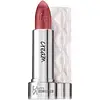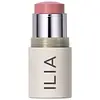What's inside
What's inside
 Key Ingredients
Key Ingredients

 Benefits
Benefits

 Concerns
Concerns

 Ingredients Side-by-side
Ingredients Side-by-side

Lanolin Oil
EmollientOleyl Erucate
EmollientHydrogenated Castor Oil Dimer Dilinoleate
Skin ConditioningAcetylated Lanolin
EmollientSesamum Indicum Seed Oil
EmollientPetrolatum
EmollientCera Microcristallina
Emulsion StabilisingTalc
AbrasiveCera Alba
EmollientParaffin
PerfumingHdi/Trimethylol Hexyllactone Crosspolymer
Synthetic Wax
AbrasiveAlumina
AbrasiveDisteardimonium Hectorite
StabilisingTocopheryl Acetate
AntioxidantVinyl Dimethicone/Methicone Silsesquioxane Crosspolymer
Parfum
MaskingPentaerythrityl Tetraisostearate
EmollientPolyhydroxystearic Acid
EmulsifyingPentaerythrityl Tetra-Di-T-Butyl Hydroxyhydrocinnamate
AntioxidantSilica
AbrasiveAluminum Hydroxide
EmollientAcrylic Acid/Isobutyl Acrylate/Isobornyl Acrylate Copolymer
Octyldodecyl Neopentanoate
EmollientLimonene
PerfumingBHT
AntioxidantTocopherol
AntioxidantHydrogenated Palm Glycerides Citrate
EmollientSodium Hyaluronate
HumectantHydrogenated Jojoba Oil
AbrasiveMentha Piperita Oil
MaskingButyrospermum Parkii Butter
Skin ConditioningWater
Skin ConditioningPropylene Glycol
HumectantSilica Dimethyl Silylate
EmollientPhenoxyethanol
PreservativeSoluble Collagen
HumectantButylene Glycol
HumectantSodium Chondroitin Sulfate
Skin ConditioningCaprylyl Glycol
EmollientAtelocollagen
Skin ConditioningHexylene Glycol
EmulsifyingTrisodium EDTA
Potassium Sorbate
PreservativeCitric Acid
BufferingCI 77891
Cosmetic ColorantCI 77491
Cosmetic ColorantCI 77492
Cosmetic ColorantCI 77499
Cosmetic ColorantCI 15850
Cosmetic ColorantCI 45410
Cosmetic ColorantMica
Cosmetic ColorantCI 45380
Cosmetic ColorantCI 15985
Cosmetic ColorantCI 19140
Cosmetic ColorantCI 42090
Cosmetic ColorantLanolin Oil, Oleyl Erucate, Hydrogenated Castor Oil Dimer Dilinoleate, Acetylated Lanolin, Sesamum Indicum Seed Oil, Petrolatum, Cera Microcristallina, Talc, Cera Alba, Paraffin, Hdi/Trimethylol Hexyllactone Crosspolymer, Synthetic Wax, Alumina, Disteardimonium Hectorite, Tocopheryl Acetate, Vinyl Dimethicone/Methicone Silsesquioxane Crosspolymer, Parfum, Pentaerythrityl Tetraisostearate, Polyhydroxystearic Acid, Pentaerythrityl Tetra-Di-T-Butyl Hydroxyhydrocinnamate, Silica, Aluminum Hydroxide, Acrylic Acid/Isobutyl Acrylate/Isobornyl Acrylate Copolymer, Octyldodecyl Neopentanoate, Limonene, BHT, Tocopherol, Hydrogenated Palm Glycerides Citrate, Sodium Hyaluronate, Hydrogenated Jojoba Oil, Mentha Piperita Oil, Butyrospermum Parkii Butter, Water, Propylene Glycol, Silica Dimethyl Silylate, Phenoxyethanol, Soluble Collagen, Butylene Glycol, Sodium Chondroitin Sulfate, Caprylyl Glycol, Atelocollagen, Hexylene Glycol, Trisodium EDTA, Potassium Sorbate, Citric Acid, CI 77891, CI 77491, CI 77492, CI 77499, CI 15850, CI 45410, Mica, CI 45380, CI 15985, CI 19140, CI 42090
Helianthus Annuus Seed Oil
EmollientRicinus Communis Seed Oil
MaskingTheobroma Cacao Seed Butter
EmollientCera Alba
EmollientEuphorbia Cerifera Cera
AstringentButyrospermum Parkii Butter
Skin ConditioningCitrus Aurantium Dulcis Peel Cera
EmollientSesamum Indicum Seed Oil
EmollientZea Mays Starch
AbsorbentCitric Acid
BufferingPersea Gratissima Oil
Skin ConditioningTocopherol
AntioxidantIron Oxides
Mica
Cosmetic ColorantCI 45410
Cosmetic ColorantCI 15850
Cosmetic ColorantCI 77891
Cosmetic ColorantCI 19140
Cosmetic ColorantHelianthus Annuus Seed Oil, Ricinus Communis Seed Oil, Theobroma Cacao Seed Butter, Cera Alba, Euphorbia Cerifera Cera, Butyrospermum Parkii Butter, Citrus Aurantium Dulcis Peel Cera, Sesamum Indicum Seed Oil, Zea Mays Starch, Citric Acid, Persea Gratissima Oil, Tocopherol, Iron Oxides, Mica, CI 45410, CI 15850, CI 77891, CI 19140
 Reviews
Reviews

Ingredients Explained
These ingredients are found in both products.
Ingredients higher up in an ingredient list are typically present in a larger amount.
This ingredient is also known as shea butter. It is an effective skin hydrator and emollient.
Emollients help soothe and soften your skin. It does this by creating a protective film on your skin. This barrier helps trap moisture and keeps your skin hydrated. Emollients may be effective at treating dry or itchy skin.
Shea butter is rich in antioxidants. Antioxidants help fight free-radicals, or molecules that may harm the body. It is also full of fatty acids including stearic acid and linoleic acid. These acids help replenish the skin and keep skin moisturized.
While Shea Butter has an SPF rating of about 3-4, it is not a sunscreen replacement.
Shea butter may not be fungal acne safe. We recommend speaking with a professional if you have any concerns.
Learn more about Butyrospermum Parkii ButterCera alba is beeswax, or the wax used by bees to make honeycombs. It is a texture-enhancer and emollient. A study from 2003 found beeswax to be a stronger emollient than ingredients such as petroleum jelly.
As an emollient, beeswax helps hydrate the skin by creating a barrier on top. This barrier traps moisture in.
Emulsifiers help prevent ingredients from separating. This helps create consistent texture.
The structure of beeswax is mainly long-chain alcohols and the esters of fatty acids.
There are three types of beeswax: yellow, white, and absolute. Yellow is pure beeswax taken from the honeycomb. White beeswax is created by filtering or bleaching yellow beeswax. Absolute beeswax is created by treating beeswax with alcohol. Beeswax used in cosmetics are purified.
Beeswax has been used throughout history and even in prehistoric times. Some common uses for beeswax still used today are making candles, as a waterproofing agent, and polish for leather.
Learn more about Cera AlbaCi 15850 is the pigment color red. It is an azo dye and created synthetically.
Azo dyes need to be thoroughly purified before use. This allows them to be more stable and longer-lasting.
This ingredient is common in foundations, lipsticks, and blushes. This color is described as brown/orangey red.
It has many secondary names such as Red 6 and Red 7. According to a manufacturer, Red 6 usually contains aluminum.
Learn more about CI 15850CI 19140 is also known as Tartrazine. Tartrazine is a synthetic dye used in cosmetics, foods, and medicine to add a yellow color.
Tartrazine is created from petroleum and is water-soluble.
Some people may experience allergies from this dye, especially asthmatics and those with an aspirin intolerance.
Learn more about CI 19140CI 45410 is a synthetic red-pigment and dye.
It often goes by both Red 28 or Red 27; manufacturers label both ingredients as CI 45410.
This dye is commonly found in makeup because it imparts a vivid color. Some types of this dye change color based on pH level and interaction with moisture:
Your skin has a natural pH of around 4.5 - 5.5.
According to the FDA, CI 45410 is not permitted for use in eye products.
Red 27 is a flourescein dye and commonly used as a fluorescent tracer in medicine.
Learn more about CI 45410Ci 77891 is a white pigment from Titanium dioxide. It is naturally found in minerals such as rutile and ilmenite.
It's main function is to add a white color to cosmetics. It can also be mixed with other colors to create different shades.
Ci 77891 is commonly found in sunscreens due to its ability to block UV rays.
Learn more about CI 77891Citric Acid is an alpha hydroxy acid (AHA) naturally found in citrus fruits like oranges, lemons, and limes.
Like other AHAs, citric acid can exfoliate skin by breaking down the bonds that hold dead skin cells together. This helps reveal smoother and brighter skin underneath.
However, this exfoliating effect only happens at high concentrations (20%) which can be hard to find in cosmetic products.
Due to this, citric acid is usually included in small amounts as a pH adjuster. This helps keep products slightly more acidic and compatible with skin's natural pH.
In skincare formulas, citric acid can:
While it can provide some skin benefits, research shows lactic acid and glycolic acid are generally more effective and less irritating exfoliants.
Most citric acid used in skincare today is made by fermenting sugars (usually from molasses). This synthetic version is identical to the natural citrus form but easier to stabilize and use in formulations.
Read more about some other popular AHA's here:
Learn more about Citric AcidMica is a naturally occurring mineral used to add shimmer and color in cosmetics. It can also help improve the texture of a product or give it an opaque, white/silver color.
Serecite is the name for very fine but ragged grains of mica.
This ingredient is often coated with metal oxides like titanium dioxide. Trace amounts of heavy metals may be found in mica, but these metals are not harmful in our personal products.
Mica has been used since prehistoric times throughout the world. Ancient Egyptian, Indian, Greek, Roman, Aztec, and Chinese civilizations have used mica.
Learn more about MicaSesame oil comes from sesame seeds. Sesame oil is rich in fatty acids and Vitamin E.
It has antibacterial, antioxidant, and anti-inflammatory properties. The phenolic compounds of this ingredient (including vitamin E) give it these properties.
Unrefined sesame oil has a comedogenic rating of 3, while refined sesame oil has a rating of 1. This ingredient may not be fungal-acne safe.
The fatty acids in sesame oil include linoleic acid (41%), oleic acid (39%), palmitic acid (8%), stearic acid (5%), and some small traces of others.
Learn more about Sesamum Indicum Seed OilTocopherol (also known as Vitamin E) is a common antioxidant used to help protect the skin from free-radicals and strengthen the skin barrier. It's also fat soluble - this means our skin is great at absorbing it.
Vitamin E also helps keep your natural skin lipids healthy. Your lipid skin barrier naturally consists of lipids, ceramides, and fatty acids. Vitamin E offers extra protection for your skin’s lipid barrier, keeping your skin healthy and nourished.
Another benefit is a bit of UV protection. Vitamin E helps reduce the damage caused by UVB rays. (It should not replace your sunscreen). Combining it with Vitamin C can decrease sunburned cells and hyperpigmentation after UV exposure.
You might have noticed Vitamin E + C often paired together. This is because it is great at stabilizing Vitamin C. Using the two together helps increase the effectiveness of both ingredients.
There are often claims that Vitamin E can reduce/prevent scarring, but these claims haven't been confirmed by scientific research.
Learn more about Tocopherol